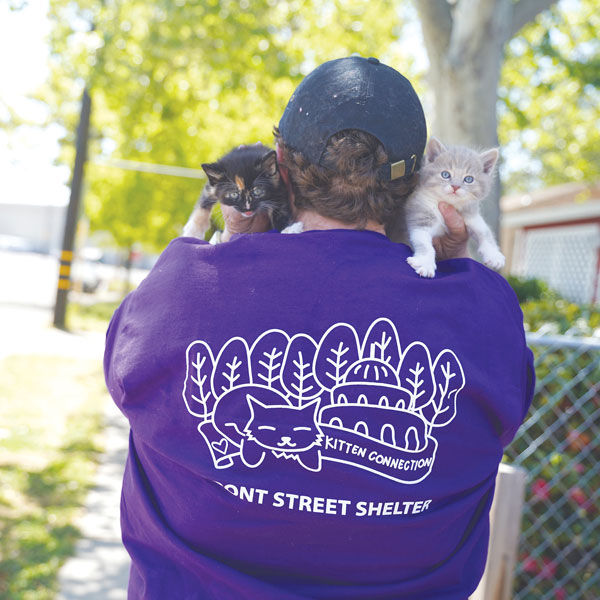Soft mews came from the church ceiling. Staff could hear the kittens crying, but could not access the fragile felines.
Kitten Connection to the rescue.
“I could see the kittens in an AC duct,” says Stephanie McCall, a Kitten Connection volunteer. She grabbed a cardboard box, climbed a ladder and opened the air conditioning grate. “They all fell right into the box. I felt like Wonder Woman.”

Four 6-week-old females—three calicos and a black and white—were trapped without mom, food or water for almost a week following repairs at the church in Del Paso Heights. An emergency exam by a local veterinarian found them underweight but healthy. “They went into foster care and they’re doing great,” McCall says.
Kitten Connection is a community-based volunteer program run by the city’s Front Street Animal Shelter. A team of approximately 12 trained volunteers are on-call 24 hours a day, hitting the streets, backyards and alleyways to respond to requests from the community to help stray kittens.
But Kitten Connection is not just about dispatching volunteers to pick up homeless felines. The program is tailored to assess situations and find best options, even if that means leaving the youngsters where they are.
Historically, animal control officers were dispatched to these calls. But with officers receiving 16,000 animal-related service requests a year, there is little time to evaluate each circumstance and create a plan for an optimum outcome.
“Inevitably, the officers would pick up the kittens, take them to the shelter and head off to the next call,” says Jace Huggins, Front’s Street chief of field services, who created Kitten Connection. “I wanted to find a way to add an educational component to our responses. We focus on when it’s appropriate to bring kittens in and when it’s appropriate to leave them in the field.”
McCall has been volunteering at Front Street for seven years and has fostered more than 800 kittens. She and the other Kitten Connection volunteers have the knowledge and experience to make the program a success, which includes educating the public.
“People would see a litter of kittens and make an assumption that mom must not be coming around—and just take them to the shelter,” Huggins says. “But the shelter is not the best place for a newborn kitten. We can’t provide it with the same nutrients that mom can, the same temperature controls. Mama cat is the absolute best provider for that care.”
In addition, foster caregivers trained to care for “bottle babies” are scarce. “So let’s work triply hard to make sure mom isn’t coming around before we go in and swoop up kittens,” Huggins adds.
Kitten Connection volunteers scatter flour over the ground and return in a couple hours to look for mom’s pawprints. They scan for hiding places. They determine if the kittens are healthy. “You can tell a lot if the mama cat is coming around just by looking at the kittens,” Huggins says. “The volunteers’ specialty is figuring out when a kitten really needs to go and when it can stay where it’s at.”
When the kittens are 5 to 6 weeks old and eating on their own, Kitten Connection volunteers are called back to retrieve the youngsters and mom (which may entail setting humane traps). The kittens are spayed or neutered and put up for adoption. After her spay, mom is typically returned to her home base. “If she is friendly, there is a possibility that she has a home to go back to,” Huggins says. “The key is to get them altered so they are not having more litters.”
Sick, injured and “bottle babies” with no sign of mom are picked up immediately. “We also create foster families right there in the field,” Huggins explains. “People who are glad to keep the kittens and take care of them until they are old enough to be spayed or neutered.” Kitten Connection volunteers come prepared with supplies, including formula, bottles, heating discs and wet kitten food, to leave with the caller.
Because calls to the Front Street Animal Shelter go through Sacramento’s 311 system, Huggins developed Kitten Connection to work within the system. The program seems to be working.
“Kitten Connection has allowed 311 to handle the overwhelming number of calls for kittens received daily much more quickly and efficiently,” says Suzanne Solorzano, a 311 Call Center agent. “Their assistance has greatly improved response times for priority calls, freeing animal control officers to handle other emergency calls throughout the city.”
Kitten Connection, which operates within the city limi
ts, has been up and running since the beginning of the year. Now, with “kitten season” in full swing, the program is more critical than ever.
“It’s not a perfect system,” Huggins says. “We are not going to be able to get them all. This isn’t a short sprint. It’s a marathon. We are doing the best we can. But we’re doing more than we were before, which is the most important thing.”
To volunteer for Kitten Connection, sign up for Front Street’s online volunteer orientation at cityofsacramento.org/community-development/animal-care. For more information, contact Huggins at jhuggins@cityofsacramento.org.
Cathryn Rakich can be reached at crakich@surewest.net. Follow us on Facebook, Twitter and Instagram: @insidesacramento.
















